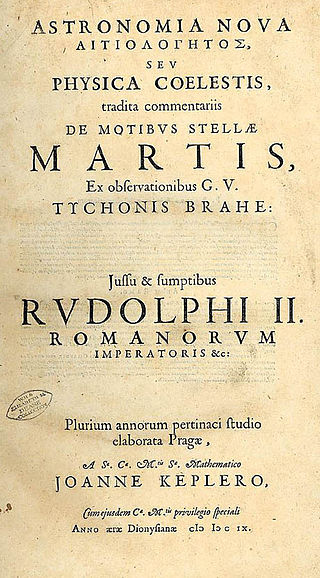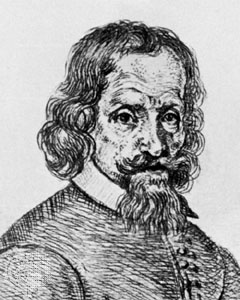Related Research Articles

Johannes Kepler was a German astronomer, mathematician, astrologer, natural philosopher and writer on music. He is a key figure in the 17th-century Scientific Revolution, best known for his laws of planetary motion, and his books Astronomia nova, Harmonice Mundi, and Epitome Astronomiae Copernicanae, influencing among others Isaac Newton, providing one of the foundations for his theory of universal gravitation. The variety and impact of his work made Kepler one of the founders and fathers of modern astronomy, the scientific method, natural and modern science. He has been described as the "father of science fiction" for his novel Somnium.

1604 (MDCIV) was a leap year starting on Thursday of the Gregorian calendar and a leap year starting on Sunday of the Julian calendar, the 1604th year of the Common Era (CE) and Anno Domini (AD) designations, the 604th year of the 2nd millennium, the 4th year of the 17th century, and the 5th year of the 1600s decade. As of the start of 1604, the Gregorian calendar was 10 days ahead of the Julian calendar, which remained in localized use until 1923.

SN 1604, also known as Kepler's Supernova, Kepler's Nova or Kepler's Star, was a Type Ia supernova that occurred in the Milky Way, in the constellation Ophiuchus. Appearing in 1604, it is the most recent supernova in the Milky Way galaxy to have been unquestionably observed by the naked eye, occurring no farther than 6 kiloparsecs from Earth. Before the adoption of the current naming system for supernovae, it was named for Johannes Kepler, the German astronomer who described it in De Stella Nova.
David Fabricius was a German pastor who made two major discoveries in the early days of telescopic astronomy, jointly with his eldest son, Johannes Fabricius (1587–1615).

Wagonways, also known as horse-drawn railways and horse-drawn railroad consisted of the horses, equipment and tracks used for hauling wagons, which preceded steam-powered railways. The terms plateway, tramway, dramway, were used. The advantage of wagonways was that far bigger loads could be transported with the same power.

Simon Marius was a German astronomer. He was born in Gunzenhausen, near Nuremberg, but spent most of his life in the city of Ansbach. He is best known for being among the first observers of the four largest moons of Jupiter, and his publication of his discovery led to charges of plagiarism.

Girolamo Fabrici d'Acquapendente, also known as Girolamo Fabrizio or Hieronymus Fabricius, was a pioneering anatomist and surgeon known in medical science as "The Father of Embryology."

The year 1609 in science and technology involved some significant events.

Johann Rudolf Glauber was a German-Dutch alchemist and chemist. Some historians of science have described him as one of the first chemical engineers. His discovery of sodium sulfate in 1625 led to the compound being named after him: "Glauber's salt".

Wollaton is a suburb and former civil parish in the western part of Nottingham, in the Nottingham district, in the ceremonial county of Nottinghamshire, England. Wollaton has two wards in the City of Nottingham, with a total population of 24,693 at the 2011 census. It is home to Wollaton Hall, with its museum, deer park, lake, walks and golf course.

SN 1572, or B Cassiopeiae, was a supernova of Type Ia in the constellation Cassiopeia, one of eight supernovae visible to the naked eye in historical records. It appeared in early November 1572 and was independently discovered by many individuals.

Michael Maestlin was a German astronomer and mathematician, known for being the mentor of Johannes Kepler. He was a student of Philipp Apian and was known as the teacher who most influenced Kepler. Maestlin was considered to be one of the most significant astronomers between the time of Copernicus and Kepler.
Ian Keith Shelton is a Canadian astronomer who discovered SN 1987A, the first modern supernova close and bright enough to be visible to the naked eye.

The Wollaton Wagonway, built between October 1603 and 1604 in the East Midlands of England by Huntingdon Beaumont in partnership with Sir Percival Willoughby, has sometimes been credited as the world's first overground wagonway and therefore regarded as a significant step in the development of railways. Its primacy has been recently questioned because of a wagonway built at Prescot, near Liverpool, sometime around 1600 and possibly as early as 1594. Owned by Philip Layton, this line carried coal from a pit near Prescot Hall to a terminus about half a mile away. Also, a wagonway at Broseley in Shropshire was probably earlier.

Sir Percival Willoughby of Wollaton Hall, Nottinghamshire was a prominent land owner, businessman, and entrepreneur involved during his lifetime variously in mining, iron smelting, and glass making enterprises in Nottinghamshire. He was also an important investor in the Newfoundland Company.

The known history of supernova observation goes back to 1006 AD. All earlier proposals for supernova observations are speculations with many alternatives.

Janus Cornarius was a Saxon humanist and friend of Erasmus. A gifted philologist, Cornarius specialized in editing and translating Greek and Latin medical writers with "prodigious industry," taking a particular interest in botanical pharmacology and the effects of environment on illness and the body. Early in his career, Cornarius also worked with Greek poetry, and later in his life Greek philosophy; he was, in the words of Friedrich August Wolf, "a great lover of the Greeks." Patristic texts of the 4th century were another of his interests. Some of his own writing is extant, including a book on the causes of plague and a collection of lectures for medical students.

De Stella Nova in Pede Serpentarii, generally known as De Stella Nova was a book written by Johannes Kepler between 1605 and 1606, when the book was published in Prague.

Joseph Duchesne or du Chesne was a French physician. A follower of Paracelsus, he is now remembered for important if transitional alchemical theories. He called sugar toxic, saying: “Under its whiteness, sugar hides a great blackness.”

Johannes van Heeck,, was a Dutch physician, naturalist, alchemist and astrologer. Together with Prince Federico Cesi, Anastasio de Filiis and Francesco Stelluti, he was one of the four founding members of the Accademia dei Lincei, the first learned society dedicated to understanding of the natural world through scientific enquiry.
References
- ↑ "SN 1604, Kepler's Supernova". Archived from the original on 31 January 2010. Retrieved 22 June 2011.
- ↑ "Three Great Eyes on Kepler's Supernova Remnant". NASA. Archived from the original on 1 November 2012. Retrieved 22 June 2011.
- ↑ "Tomsk Region". Kommersant . Archived from the original on 6 June 2011. Retrieved 22 June 2011.
- 1 2 Astronomiae Pars Optica . Manuscript presented to Rudolf II, Holy Roman Emperor, 1 January.
- ↑ Hieronymus Fabricius (1624). De formato foetu, liber (in Latin). Jacobus De Zetter.
- ↑ Joseph Du Chesne (1605). Ad Veritatem Hermeticae Medicinae ex Hippocratis veterumque decretis ac Therapeusi (in Latin). Nebenius.
- ↑ Smith, Richard S. (1960). "England's first rails: a reconsideration". Renaissance & Modern Studies. 4: 119–134.
- ↑ New, John (2004). "400 years of English railways: Huntingdon Beaumont and the early years". BackTrack . 18: 660–5.
- ↑ Waggonway Research Circle (August 2005). "The Wollaton Wagonway of 1604: the World's first overland railway" (PDF). Archived from the original (PDF) on 18 February 2012. Retrieved 16 January 2012.
- ↑ "The Galileo Project". galileo.rice.edu. Retrieved 5 April 2018.